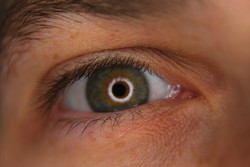Looking to the future through the first autonomous artificial iris
Researchers from the PHOTOTUNE project recently published a study in the Advanced Materials journal, which announced the creation of an artificial iris which can react to light much as a human eye does. The study harnessed so-called photoalignment technology (also used in some contemporary mobile phone displays) in conjunction with light-sensitive liquid crystal elastomers (LCEs or networks of polymer chains) to manufacture the iris. What makes the invention stand out is its ability to function more autonomously than previous efforts, as it does not rely on external light detection systems or power sources. The head of the research group, Associate Professor Arri Priimägi elucidates, ‘An autonomous iris that can independently adjust its shape and the size of its aperture in response to the amount of incoming light is a new innovation in the field of light deformable materials.’ Exploring potential biomedical applications The iris is a tissue in the eye which controls the amount of light that is let into the eye through alteration of the eye’s pupil size. Ensuring that the eye’s retina receives the right amount of light is key to enabling vision with any degree of high quality and definition. As Associate Professor Priimägi describes the new technology, ‘The artificial iris looks a little bit like a contact lens and its centre opens and closes according to the amount of light that hits it.’ The same process is harnessed by camera technology. However, cameras rely on a process that uses light detection systems to adjust the amount of incoming light, which then reaches the image sensors in digital cameras and film in analogue versions, so producing high-quality pictures. The most obvious medical application of the technology is for the treatment of iris defects, but the researchers acknowledge that much work still lies ahead to fine-tune the technology before it is ready to be rolled out. As Associate Professor Priimägi further explains, ‘Our next goal is to make the iris function also in aqueous environments. Another important goal will be to increase the sensitivity of the device in order to make it react to smaller changes in the amount of incoming light. These developments will be the next steps towards possible biomedical applications.’ Photonics helping to herald the age of ‘soft robots’ More broadly, the PHOTOTUNE (Tunable Photonic Structures via Photomechanical Actuation) project was set up to develop a range of functional and stimuli-responsive materials based on polymers and liquid crystals, with particular focus on light-controllable systems. A specific area of interest for the researchers is the exploration of potential applications for so-called ‘soft robotics’. Earlier this year the team published a study in the Nature Communications journal about their advances in developing a light-activated polymer gripper. They have likened the functioning of this device to that of a Venus flytrap plant as, PHOTOTUNE uses their light-driven technology to achieve what they call ‘feedback-type actuation’. This enabled the device to display autonomous object recognition, including the ability to make selections from amongst those objects based on pre-determined characteristics. For more information, please see: CORDIS project webpage
Countries
Finland



